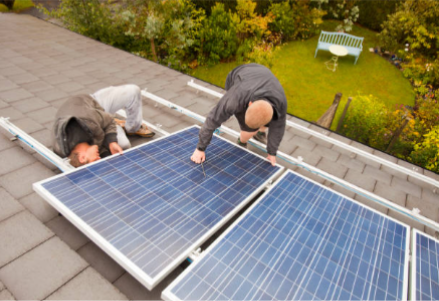The Energy Efficient Mortgage (EEM) program allows homeowners to finance upgrades that increase the energy efficiency of their homes. Whether you’re looking to increase your home’s value or save on monthly utility bills, an EEM can be an excellent investment.
This guide will provide insights into the requirements and processes of obtaining an EEM for a VA loan, eligible improvements, as well as the pros and cons of the program.
VA EEM Process
Although your lender will assist you with obtaining a VA EEM, it’s important to know some of the steps involved in the process:
- Meet eligibility requirements and secure a VA loan
- Obtain a Home Energy Rating System (HERS) score, which assesses your home’s energy performance.
- Based on the energy audit report, your VA-approved lender will determine the maximum amount you can borrow through a VA EEM.
- Select the energy-efficient improvements based on the audit report and lender’s guidelines.
- Complete the loan closing process.
- Make the improvements within six months of closing your loan.
VA Energy Efficient Mortgage Guidelines
To qualify for a VA EEM, the energy improvements must:
- Permanently upgrade the home and substantially increase energy efficiency
- Be installed within six months of the loan closing date
- Not exceed $6,000 for product and installation costs
- Lower monthly mortgage payments to the likely reduction amount in monthly utility costs
Note: Each VA lender may have different guidelines, so be sure to contact your VA lender to confirm your improvements fall within their guidelines.
Eligible and Ineligible VA EEM Improvements
Since the requirements for a VA EEM may be pretty vague, many Veterans are unsure of exactly what qualifies for this financing. The chart below shows common VA EEM eligible and ineligible energy-efficient home improvements.
| Eligible Improvements | Ineligible Improvements |
| Solar water heater | Window air conditioning units |
| Insulation (doors, walls, attics, etc.) | Energy Star-rated appliances such as refrigerators or washing machines |
| Programmable thermostats | Vinyl siding |
| Energy-efficient heat pumps | New roof or shingles |
| Solar panels | |
| Furnace efficiency | |
| Weatherproofing | |
| Storm doors or windows |
Types of VA EEMs
The VA EEMs are structured into three levels classified according to the cost of improvements:
- Up to $3,000: This tier is relatively straightforward to get approved. You’ll need contractor bids or quotes itemizing the costs and provide installation information for each improvement.
- $3,000 to $6,000: In addition to the information necessary for the first tier, you’ll also need lender approval and an energy audit. An energy audit shows a year’s worth of utility costs on average for the home. Remember, the monthly mortgage payment cannot exceed the likely reduction in monthly utility costs.
- Over $6,000: Along with the documents needed for the first two tiers, you’ll need approval from your lender and the VA, making this tier of EEMs the most challenging to obtain but still possible.
The chart below shows the requirements for each tier:
| Up to $3,000 | $3,000 to $6,000 | Over $6,000 | |
| Energy Audit | No | Yes | Yes |
| Lender Approval | No | Yes | Yes |
| VA Determination | No | No | Yes |
It’s important to understand the energy audit proves that the desired energy improvements will significantly impact the monthly utility bill and is necessary for two more expensive tiers.
Does the VA Provide Free Solar Panels?
There isn’t a specialized solar program for disabled Veterans. Although the VA does not provide solar panels for Veterans, options like the VA EEM could be beneficial. This mortgage enables you to add improvements, such as solar heating and cooling systems, to your home.
How to Pay for a VA EEM
The VA Energy Efficient Mortgage allows you to add the costs of energy-efficiency improvements directly to your overall home loan, integrating them into your monthly mortgage payments. Make sure you are aware of your loan sum, including the enhancements, which should not exceed the home’s appraised value.
You can pair your EEM with an existing VA loan to fund energy-saving improvements, or you can opt for a refinancing option. If you’re considering refinancing, you can use the VA EEM to manage these costs, folding your upgrades into a new loan. However, if the addition of EEMs increases the new loan payment by 20% or more, your lender must certify you can afford this higher payment.
If you install the improvements yourself, the loan add-on will only be the cost of materials.
Why Get an EEM With Your VA Loan?
There is more to EEMs than saving money, here are several of the benefits of obtaining a VA EEM:
- Improved comfort and energy efficiency in home
- Improved health due to better indoor air quality
- Reduced noise pollution
- Reduced environmental pollution
- Increase the value of your home, potentially leading to higher resale value
Potential Drawbacks of an EEM
While VA EEMs allow many Veterans to improve the quality of their home, it may not be the best option for everyone. Before obtaining an EEM, consider these potential problems:
- It may take several years to recoup the money spent on energy-efficient improvements
- The maximum loan amount for a VA EEM is typically limited to $6,000 unless specific circumstances apply
VA EEM Eligibility: What is a HERS Score?
Understanding what exactly a Home Energy Rating System (HERS) score is will help you determine if a VA EEM is the right financial tool for your energy-efficient home improvements.
The score ranges from 0-150 and provides a standardized evaluation of a home’s energy efficiency and its expected energy costs. The lower the score, the less energy a home is using. Typically, the baseline score for a new home is 100, so you’ll want a high HERS score above 100 to qualify.
Contact the Residential Energy Services Network (RESNET) for a HERS score. A certified RESNET energy rater can verify your HERS score, which you can use to determine possible energy-efficient improvements.




About the comments on this site:
These responses are not provided or commissioned by the bank advertiser. Responses have not been reviewed, approved or otherwise endorsed by the bank advertiser. It is not the bank advertiser’s responsibility to ensure all posts and/or questions are answered.